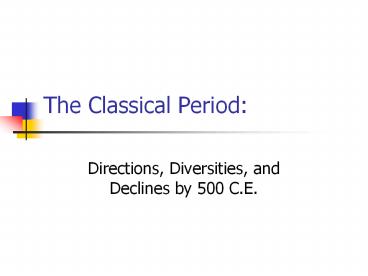The Classical Period: - PowerPoint PPT Presentation
1 / 13
Title:
The Classical Period:
Description:
The Classical Period: Directions, Diversities, and Declines by 500 C.E. Expansion and Integration As Classical Civilizations decline major world religions rise as a ... – PowerPoint PPT presentation
Number of Views:104
Avg rating:3.0/5.0
Title: The Classical Period:
1
The Classical Period
- Directions, Diversities, and Declines by 500 C.E.
2
Expansion and Integration
- As Classical Civilizations decline major world
religions rise as a force to define the next
period - Each civilization had to deal with expansion and
integration and how they dealt with these issues
helped determine how they fell - Integration
- Territorial
- Social
3
Decline of China
- Internal Problems
- Decrease in Confucian intellectuals
- Increase in corrupt bureaucrats
- Increase in social unrest partly due to declining
resources from environmental damage (such as
deforestation, soil erosion, silted rivers) - Increase in epidemics killing the population
- Threatened cultural unity with the introduction
of Buddhism - Sui and Tang revive the empire briefly
- NO PERMANENT DISRUPTION
4
Indias Decline
- Indias decline was less dramatic
- Increase in invasions, led to an increase in
regional princes. In turn, central power
weakened. However, many invaders integrated and
even adopted some of the religious views of the
conquered people. - Hinduism cemented the culture and lessened the
fall but Islam would soon threaten it.
5
Fall of Rome
- There were symptoms of decay after 180 CE
- Internal problems
- Drastic decrease in population (1 million
250,000) due to plague and disease - Depressed society
- Elite become more pleasure-seeking and so no new
culture is being created
6
Fall of Rome (contd.)
- Diocletion tried to reverse the trend but
couldnt - Constantine thinks dividing the empire will help
manage its problems but that doesnt work either - This leads to a split in the unity Mediterranean
culture - Did not produce shared political culture or the
bureaucratic institutions of China nor did is
have the religion to hold it together as in India
- Empire fell into 3 zones
- Eastern Empire- Byzantium
- N. Africa and Southern shores of Mediterranean
- Western part of the Empire (with no sophisticated
culture)
7
(No Transcript)
8
- All civilizations suffered from outside invasions
- Rome fell to Germanic invasions
- India fell to the White Huns and China to another
similar Central Asian group called the Xiongnu
9
Cases of Expanded Empires and their Influence
- Southeast Asia
- Gained access to civilization through contact
with India - Africa
- Independent kingdom of Kush along the upper Nile,
which fell to Axum, which in turn fell to
Ethiopia - Axum and Ethiopia had contacts with the
Mediterranean civ.
10
Other Civilizations
- Africa
- Below the Sahara the major development was a
further extension of agriculture and the
development of regional Kingdoms (Ghana is first
state) - Asia (Japan)
- Japan, by 200 CE, had established extensive
agriculture - Shintoism provided for worship of political
rulers and spirits of nature and by 700 CE was
able to unify Japan
11
Other Civilizations
- Asia (Polynesian)
- Reached Fiji and Somao by 1000 BCE (via special
canoes) - Central Asia
- Herding people played large role in trade,
innovation and later invasion of the classical
societies
12
Other Civilizations
- Europe
- Europe is organized into loose kingdoms
- Central America
- Olmecs develop impressive agriculture but by 400
BCE had disappeared without a trace - Olmec successors- Maya and Inca both develop in
relative isolation and therefore lacked some of
the advantages of being able to copy other
civilizations but they were sophisticated
nonetheless
13
- New Religious Map- the spread of major religions
was a vital result of changes in the classical
world































